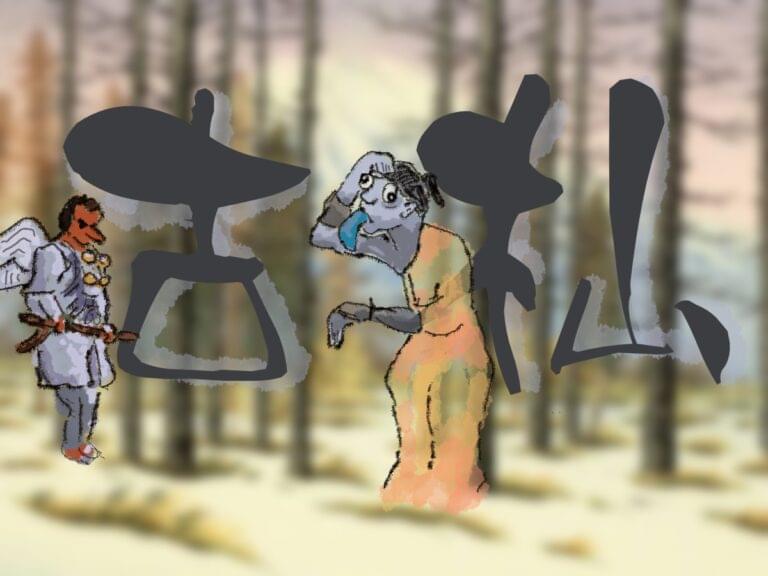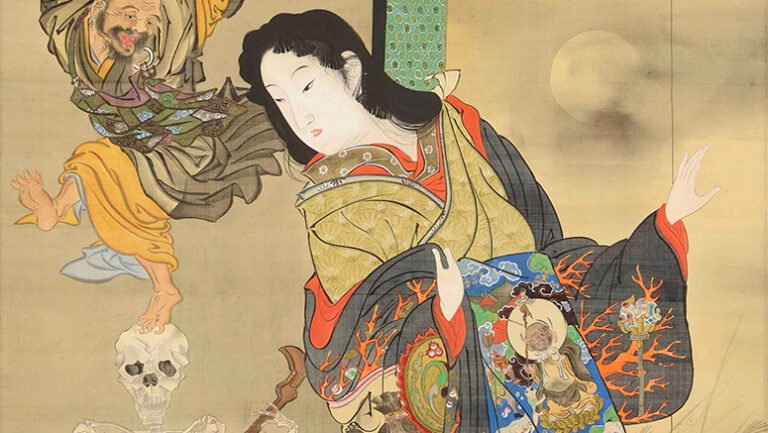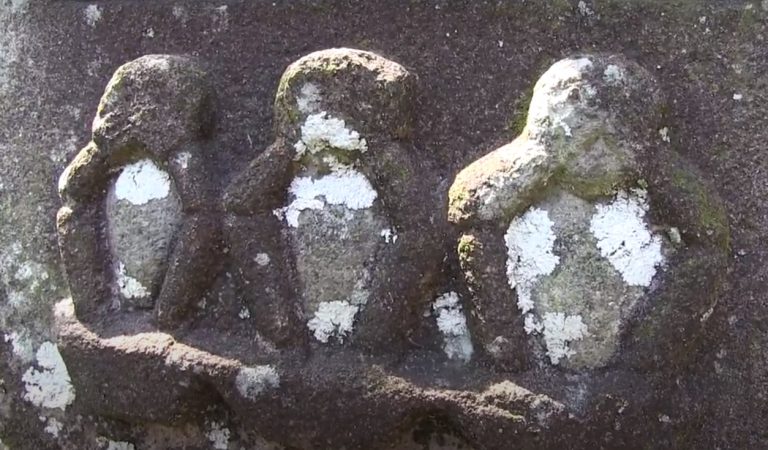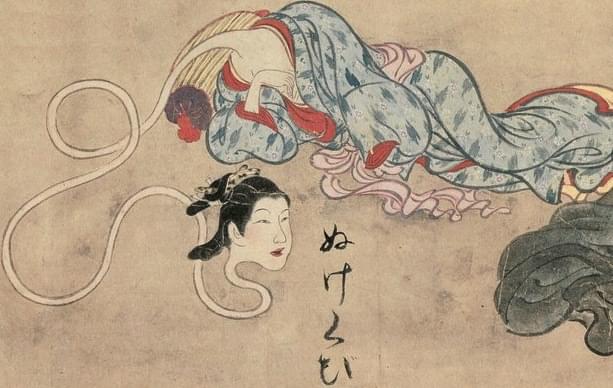Today I’m going to talk about supernatural cats, specifically, the nekomata. The nekomata is a mysterious feline with two tails and a penchant for dancing.
Hey hey, this is Thersa Matsuura and you’re listening to Uncanny Japan.
Today I want to talk about cats. Not all cats, special cats. Cats that have supernatural powers or can transform into other things, even cats that practice necromancy, because that was a thing that happened back in the day.
Keep listening.
Why Supernatural Cats?
So there are two reasons I’m doing an episode on cats. First, is because I was sketching various ideas for last month’s postcard for upper-tiered patrons, and I looked down and saw I’d sketched a wigged out-looking two-tailed cat, a nekomata. One of my favorites. Also one of the first short stories I ever got published was about a nekomata. So there’s a warm fuzzy, purring place in my heart for them.
The second reason is I’m still following all the news I can coming out of Ukraine and I noticed a lot of photos of people with their pets, dogs and cats, too.
Last episode was about a nine-tailed fox and over on patreon I just read Lafcadio Hearn’s essay “Ululation” which is about his thoughts on a very strange dog that he knew but howled in the most eerie way. So I have covered my canine bases for the time being. Now for felines!
What Does Bakeneko, Kaibyo, and Nekomata Mean?
You might have heard of a bake neko (化け猫). Bakeru (化ける) means to change or transform. Think of the word obake — a thing that changes or ghost. Neko, of course, means cat. So a bakeneko is a cat that changes or can transform into something else. Sometimes people.
A word you might not know, is kaibyou (怪猫). The ‘kai’ is the same as in youkai. And byou isn’t disease, it means cat! So “supernatural cat”. A bakeneko is a kind of kaibyou. Another type of kaibyou is the one I mentioned earlier, the nekomata (猫又), also a youkai cat that does strange things.
Differences Between Bakeneko and Nekomata
I poked around for as long as I could to find the exact difference, between a bakeneko and a nekomata, and there are some theories, but because of their youkai nature, their long history, and that they are found all over Japan, there’s a lot of overlap.
In general, I read one way to tell them apart is that a bakeneko has one tail, a nekomata has two. Also that a bakeneko is a cat that has died an unfortunate death, perhaps at the hands of a human, and turns into a mischievous youkai. While a nekomata is a cat that lives a long life and turns into one. Although there are a variety of forest cats who are labeled nekomata, too. A different species I presume.
My Nekomata – Soda!
I’m going to talk mostly about the nekomata today because my wee little rescue cat, Soda was one. No seriously. She did strange things and had a two-pronged tail.
Soda was actually born with a tail that twisted and curled at the end. It was fuzzy — as tails are — and the kink was very tight so it really looked like a forked tail. She could also do things like open any door in the house no matter how you cleverly fixed it so she couldn’t. Which I’m sure a lot of cat owners and lovers will say, their cat can do, too. But she did this other thing. The cats slept downstairs in the living, dining, kitchen. We’d keep the door closed so they didn’t wake us up at 5am.
Once we got Cha Cha Maru, our beagle, he had his own little place down there. But Soda wasn’t into that, so she’s open the door, let him out, then somehow… close the door, so he couldn’t get back in to bother her or her brother, Whiskey. In the middle of the night, I could hear her jumping to open the door, then hear the tick tick tick of doggy paws on hardwood floor, and when I went to check, there would be Cha Cha, but the living room door was closed. We always called her our little nekomata.
She also lived to be just five months shy of 20-years old which is definitely long enough to make the change. Oh, and once she spoke! I swear she did. She was still a kitten and very vocal and I used to talk to her telling her “Julyan’s home” or “where’s Julyan?”. So she knew my son’s name.
Then once we were sitting on the stairs and I am not kidding you, my son came in from school and Soda looked me dead in the eyes and meow-said “Julyan”. It was a soft J, more like meeyulian, but it was there. She never did it again because I think I scared the crap out of her when I scooped her up and flew downstairs yelling, She talked! She talked! Anyway, I’m partial to nekomata.
Two Kinds of Nekomata
As I just mentioned, there are two kinds of nekomata.
One that lives in forests and mountains and seem to do bad things and another that is just a normal house cat that grows very old and transforms into a one of these feline beasties. If you were wondering how long it takes for your cat to transform into a nekomata, well, that changes depending on whom you ask, but a rough estimate is 7 to 20 years. Seven years was a long time for a cat to live back in the day, so anything beyond that was otherworldly.
First Writings – Fujiwara no Teika
The first time a nekomata was written about was back in 1233 by a Fujiwara no Teika. This guy wrote about all kinds of things going on in a journal he kept for fifty six years, a journal he named Meigetsuki. Gotta love a man who names his journal. These days it’s viewed as a very important document to peek into life back in the day as he covered politics, literary events, astronomical happenings, and once, the nekomata.
He wrote that from Nara came a beastly creature with cat-like eyes, a dog-like body and it killed and ate 7 or 8 people in one night.
It didn’t say exactly that this was a youkai, or what it was, but he did give it a name. Nekomata.
What Does a Nekomata Look Like?
What does a nekomata look like? Well, they could look just like an ordinary cat. Although some accounts have them being much bigger, as big as a lion even, a little shy of 3 meters in length. Going out on a limb here and saying that’s probably the mountain ones.
Along came a scholar, Arai Hakuseki, who was the one who made the brilliant proclamation: Old cats become nekomata.
There you have it.
Okay, you know what they look like and how age seems to turn them into this supernatural being, but what do they do?
What Do Nekomata Do?
Well, dance around for one. It’s believed nekomata tie a tenugui cloth on their heads, stand on their hinds legs, and dance, dance, dance. They like to do this by your pillow when you’re sleeping at night, too.
They can also talk. There’s an account of one in 1683 that lived at a temple and was seen chatting up other cats in the neighborhood. A little later someone spotted a nekomata on a roof. It lost its footing and fell calling out the Buddha’s name as it did. I love that image so much.
Some — and again this is a blurry line between bakeneko and nekomata — can transform into people. Surely to play tricks and cause trouble.
But the fun doesn’t stop there. Another delight these furry felines can do is necromancy. This might be due to their fancy dance moves, twisting their little paws around, flipping their tails. Whatever it is, they can either cause a dead person to stand up and dance or actually bring someone who has passed away back to life.
One thing you have to remember is in old, old Japan people didn’t eat as well as they do now. Meat wasn’t always easy to come by and if you did have some you most certainly ate it yourself and didn’t feed it to your cat.
Problem with that is cats are genuine carnivores. They must eat meat. Another thing to note is old Japanese andon lanterns were often filled with fish oil. Mmm fish oil, says the cat. So can you imagine, curled up in your futon, in your tatami-matted room, dozing. It’s late at night and your lamp is still lit, the light flickering against the paper shoji windows. You hear something and open your eyes and there, standing on its hinds legs is your cat lapping up the oil in the lamp, long shadow thrown against the wall, and because of the licking going on, the flames is jumpy, so it looks like your cat is dancing.
Now I think the image is quite cute, but back in the day, especially around the Edo Period when artists were creating images of nekomata and bakeneko and storytellers were telling stories about them, they were a much more feared creature.
Nekomata Disease
They even had a dreadful disease called the nekomata byou, or nekomata disease. Although, this just might have been rabies. Which would make sense.
Is Your Cat a Nekomata?
Now I’m going to answer the question you’re all asking yourself. Is MY cat a nekomata? How can I tell?
Well, let me give you a checklist of six things that was used to tell if your little fur buddy is actually a youkai in disguise.
1. When it’s dark pet your cat the wrong way, against the lie of the fur, and if its skin glows. You got yourself a nekomata. If it doesn’t glow, you got yourself an angry cat.
2. If you find your cat drinking the oil from your oil lanterns? Very possibly a nekomata.
3. If you notice that your cat’s tail has gotten longer, moves like a snake and gives you the creeps when you look at it. Nekomata.
4. If you find your cat wanting to be around stinky things, especially if it’s fond of cuddling up to dead people. Nekomata.
Can I remind you the thing about cats needing to eat protein and dead bodies (being protein that doesn’t run away), and how nekomata are often associated with corpses and let you do the math?
5. If your cat’s tail becomes two tails. That’s a tell tale sign right there.
And finally,
6. If when no one is around your cat starts fires in the hearth or just starts fires in general. It, too, is most likely a nekomata.
So there you go.
Homemade Japanese Cat Food
Before I go let me five you a recipe for Neko Manma. Or homemade cat food. I learned this from my mother in law and while she said it was what she used to feed the cat, people eat it as a light and easy meal. Basically it’s rice that has either been sprinkled with miso soup or shaved bonito flakes. Sometimes you can find sushi rolls that only have the katsuobushi, dried bonito shavings, and they’re called Cat Rolls. Neko Maki.
Keep in mind that pouring miso soup on your rice is as far as I’ve experienced uncouth. It’s not a polite way to eat. But back when people were very poor and starving I believe it was tolerated.
Anything that didn’t make it into today’s episode, cool ukiyo-e I found included, I’ll put up on Patreon for patrons. I think I’m going to start doing that. All the odds and ends that don’t make it into the show I’ll stick over there.
Thank you for listening. I’ll talk to you again real soon!
Bye bye.
Credits
Intro and outro music by Julyan Ray Matsuura






